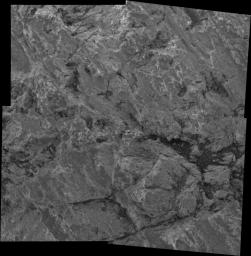
|
Eye on “Bounce”
- Click the image above for a larger view
- Full-Res JPEG (2054 x 2096) (525.0 kB)
- Full-Res TIFF (2054 x 2096) (3.8 MB)
Caption:
This mosaic, created from four images taken by the Mars Exploration Rover Opportunity's microscopic imager, outlines the target on "Bounce" rock that the rover's rock abrasion tool will abrade on sol 66.
This 6-centimeter-square (2.4-inch-square) area was chosen by the rock abrasion tool team as the most advantageous area for grinding.
Preliminary results from the rover's miniature thermal emission spectrometer show that Bounce is rich in hematite. Bounce contains spherules, or "blueberries," like some rocks in the "Eagle Crater" outcrop. However, Bounce's spherules appear smaller and may be formed by an entirely different process. The blueberries seen in the outcrop are typically 3 to 4 millimeters (0.12 to 0.16 inch) each. A good example of a cluster of micro-berries can be seen just left of center in this image. Scientists are currently studying all of the rock's features as well as its chemical content. After next sol's grinding operation, the team will be able to compare the rock's exterior and interior chemical compositions.
Cataloging Keywords:
| Name | Value | Additional Values |
|---|---|---|
| Target | Mars | |
| System | ||
| Target Type | Planet | |
| Mission | Mars Exploration Rover (MER) | |
| Instrument Host | Opportunity (MER-B) | |
| Host Type | Rover | |
| Instrument | Microscopic Imager (MI) | Miniature Thermal Emission Spectrometer (Mini-TES), Rock Abrasion Tool (RAT) |
| Detector | ||
| Extra Keywords | Crater, Grayscale, Thermal | |
| Acquisition Date | ||
| Release Date | 2004-03-31 | |
| Date in Caption | ||
| Image Credit | NASA/JPL | |
| Source | photojournal.jpl.nasa.gov/catalog/PIA05660 | |
| Identifier | PIA05660 | |
